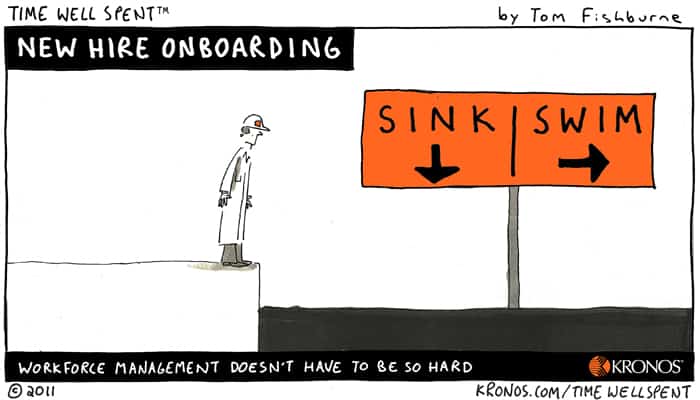Onboarding: Continue the Momentum from Hiring

Welcome to the Reflectivity Blog!
For the first post thought we would start with a topic that is fitting, Employee Onboarding.
There is a lot of goodwill and enthusiasm generated from recruitment through hiring. The next step would be to continue that momentum and excitement with onboarding. How do all the expectations get translated when a new employee starts?
Key Takeaways
- Have a structured process for onboarding to provide knowledge and familiarity
- Make the onboarding process supportive and collaborative
- Establish engagement and trust from the beginning
Inclusive Onboarding
All companies, whether they are a startup or an enterprise, recognize the need for some onboarding period. Onboarding programs have been shown to improve performance by 11.5%.1
The first 6 months for a new employee are crucial as 90% of employees decide whether they will stay with or leave an organization.2 Also, half of all senior-level outside hires fail within 18 months.3
For many companies, the way to onboard a new employee is using a Darwinian method: survival of the fittest. The day an employee starts, give them a task and hope they can figure it out from there. This approach is about having a short period called “onboarding” rather than having a structured process.
This “onboarding” process leaves it to luck to whether a new employee will not only perform their tasks well but also will thrive in the company.
A new employee wants to make an impact right away, to become a member of the team and to perform their duties well. A new employee does not want to look foolish and to interrupt others with questions. So what is that employee to do?
What will catapult new employees for long-term success and that they will want to stay with the company? How do you make an inclusive onboarding process that can adapt for all employees? What are the outcomes that would be ideal? What is a realistic timeline for that to occur? Is that the same for every employee?
Engage the New Employee
To answer some of these questions, start by having an existing team member learn to be an onboarding buddy. Wherever possible, a buddy should be a peer and not the new employee’s direct manager.
A buddy makes it their mission to have many touchpoints with the new employee. With the buddy, a new employee will not be alone on an island or need to worry about interrupting another team member. A buddy can provide insight and observations about their team and company.
However, engagement should not be left to the single team member with the role of the buddy. It should become the mindset of the entire team.
Personalize a Structured Plan
Create a structured plan that starts off slow and builds at the pace of the new employee. Employees who went through a structured onboarding program were 58% more likely to be with the organization after three years.4
A plan starts with an overview of the company, department structure, systems and tools. The next part is to assign the new employee a set of trivial tasks to work through. Completing tasks from start-to-end will help the new employee become familiar with tools and processes. This will put their focus on learning rather than worrying about solving the task itself.
After the initial trivial tasks, create a plan tailored to a new employee that will consider their level and responsibilities. During the onboarding period, the new employee will integrate into regular team and project meetings. The pace of the plan should not rush onboarding. The tasks for a new employee must not be part of a schedule until their onboarding process has completed. Their focus should be on building a solid foundation. What will be the projects they will work on when complete? What duties will they have?
A new employee should make updates to the onboarding documentation. Also to add new material that would be helpful for future hires.
Establish a Relationship with their Manager
As part of the structured plan, establish a working relationship with their manager. A regular 1-1 schedule with the new employee provides a way to build that relationship and acts as a forum for bidirectional feedback. To be meaningful, the feedback must be open, honest and constructive. This will allow a manager to better understand the employee.
A manager must gather information throughout the onboarding process. What does the new employee think of the plan? How is the employee finding onboarding? What is working? What needs work? Is there a common understanding of completion?
Outcomes
Throughout the onboarding process, a new employee will have motivation and excitement for the future.
At the end of a successful onboarding process, the new employee can fulfill their new position. The employee should have:
- Built a solid foundation on their team and in the company
- Gained domain knowledge in at least one area in depth
- Executed the tools and processes
- Taken part in meetings
- Developed a relationship with their team
- Developed a relationship with their manager
- Became comfortable asking questions and providing feedback
Ideas to Consider
Create a 30/60/90 day plan
- Provide regular intervals for feedback and update the plan if required
- Days 1-30: Observe and learn
- Days 31-60: Collaborate and start responsibilities
- Days 61-90: Increase responsibilities and start of independence
Schedule a team building event
- This may happen with preexisting scheduled events
Other Question to Consider
- How does the onboarding process differ from experience or expectations? For example, how is different between a new graduate vs responsibility of a team lead?
- What type of learner is the new employee? Does the format and material work well?
- Is there a larger plan for the placement for the new employee?
- What is the trigger for transitioning out of onboarding? Is it time-based? A structured set of criteria? Based on the employee?